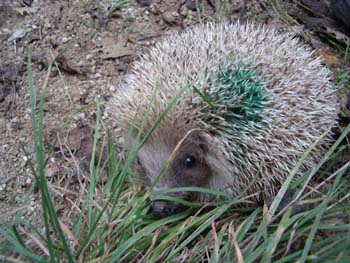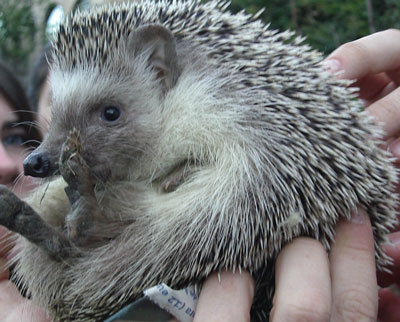There are two species of hedgehog in Spain. - See below Hedgehog mortality in Spain + Hedgehog eating tradition + Darwin on Spanish hedgehogs
Western (or European) hedgehog : erizo europeo : Erinaceus europaeus
The European hedgehog is present throughout Spain and Portugal though avoids drier areas, in particular along the Mediterranean coastal strip where it is replaced by the Algerian Hedgehog
Algerian hedgehog : erizo moruno : Atelerix algirus
The Algerian hedgehog is slightly smaller and usually lighter than its European cousin - though in these photos, the Algerian is the darker of the two -many Spanish European hedgehogs are lighter. It's spikes are softer and can be almost comfortably held in your hand. Short of doing a full autopsy on its teeth, the best way of telling the two species apart is by the ears, which are far more prominent (see photo) in the Algerian hedgehog and the lack of a widow's peak or "the spinefree 'parting' on the crown of the head" here. It also has a longer snout and longer legs, indicating that it walks more. Its other English name of vagrant hedgehog is presumably in reference to this. Considered rare, their habitat is restricted to the flat lands of the eastern Mediterranean coast where its numbers have been decimated by urban encroachment across the coastal plains, vehicles and dogs. The Algerian hedgehog was possibly introduced into the Spanish mainland from North Africa. It was certainly introduced into the Balearics, though I am unaware as to whether this was purposeful. (see eating hedgehogs below), was more recently introduced in the Canaries.
 
Top: European Hedgehog. Bottom: Algerian Hedgehog (my photos)
Hedgehog mortality in Spain
These hedgehogs form part of a study by the Barcelona wildlife group Galanthus in the Sierra Marina above Badalona, just north of Barcelona. The study, funded by Badalona Town Council, is looking at the causes of mortality among hedgehogs of both species. Preliminary results by the researchers suggest that stray and loose dogs, rather than traffic, are by far the greatest hazard to hedgehogs in the area.. Dogs must pose a huge threat to hedgehogs across Spain as 100,000's of them roam the Spanish countryside. The Catalan coastal mountains are an overlap area and both species coexist together here. In theory, the two species do not intrebreed though few (no?) studies exist on their interaction.
Hedgehog videos. Watch these short videos of the hedgehogs in the above project here Coming out of the nest - Taking material to nest - Scratching -
More here
Charles Darwin on Spanish hedgehogs
Darwin sent a letter, as a corroboration of earlier articles on hedgehogs carrying fruit on their spines, with a passage from a letter from R. Swinhoe describing hedgehogs carrying strawberries to their holes. The belief is false though hedgehogs do eat fruit. And evidently, leaves, fruit and whatnot will get stuck to their spines.
"HEDGEHOGS.-As in the August and September numbers, you have published an account of hedgehogs apparently carrying away pears and crabs sticking on their spines, you may think the following statement worth insertion as a further corroboration. I have received this account in a letter dated August 5,1867, from Mr. Swinhoe at Amoy:-"Mr. Gisbert, the Spanish Consul at Amoy, informs me that when he was an engineer on the roads in Spain some years ago, he was fond of shooting and roaming about the country. He states that in the Sierra Morena, a strawberry-tree (Arbutus unedo?) was very abundant, and bore large quantities of red, fruit-like, fine, large, red strawberries. These gave quite a glow to the woods. The district in the mountain chain he refers to, is on the divisional line between the provinces of Seville and Badajos. Under these trees hedgehogs occurred innumerable, and fed on the fruit, which the Spaniards call Madrône [sic - MADROÑO]. Mr. Gisbert has often seen an Erizo (hedgehog) trotting along with at least a dozen of these strawberries sticking on its spines. He supposes that the hedgehogs were carrying the fruit to their holes to eat in quiet and security, and that to procure them they must have rolled themselves on the fruit which was scattered in great abundance all over the ground beneath the trees."- Charles Darwin .
- From here at British Library Hardwicke's Science-Gossip: An Illustrated Medium of Interchange and Gossip for Students and Lovers of Nature , 1 Dec. 1867. p. 280.

The belief is clearly an old one. Here a pair of hedgehog roll about on the floor in order to spike grapes and take them to their burrow. From a 12th bestiary.
Eating hedgehogs
Until recently Algerian hedgehogs were captured for their meat in the Balearics, while there was a tradition of eating European hedgehogs in Portugal and the Basque Country, the latter no doubt with some ingenious Basque method of cooking them. Curative powers were ascribed to their meat. Both are now protected and as far as I know hedgehog eating has completely dispappeared in Spain. See Tradition of eating lizards in Spain
Note: an erizo de mar (sea hedgehog) is a sea urchin. Chestnut casings are known as ourizos in Galicia.
See also wildlife in Spain - Wolf watching in the Sierra de la Culebra - Spanish Bear News - Iberian Lynx News - Iberian Lynx - Badgers in Spain - Wolves in Spain -Wolves, boars and capercaillie - Deer in Spain - Barbary apes in Gibraltar - European and American mink - Coypu in Spain - Pyrenean mountain goat - English-Spanish-Latin mammal checklist for Spain - Comparative table of Castilian and Catalan dictionaries on zoology -- Bats in Spain - Chamois in Spain - European and American mink - Acorns and rats in Castile Mammals in Spain -Wild Cats in Spain
|


